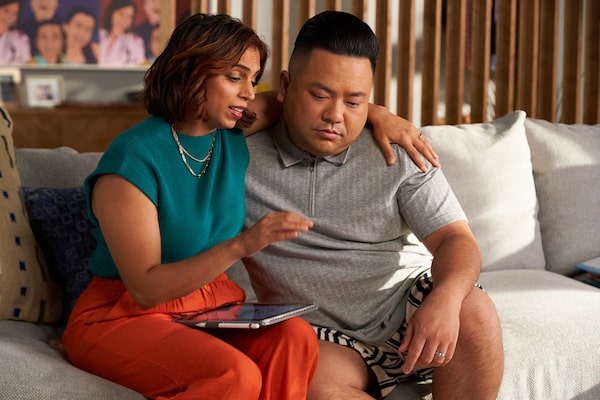
Andrew (Andrew Phung) and Camille (Rakhee Morzaria) comfort each other in a scene from the CBC Canadian sitcom Run The Burbs.Ian Watson/CBC via The Canadian Press
The latest episode of Run the Burbs – the family sitcom co-created by Kim’s Convenience alum Andrew Phung – paid tribute to actor, CBC host and comedian Candy Palmater, who died in December, 2021. She had a supporting role in the first season, playing a neighbour named Candy living in the suburban nook in a fictional town called Rockridge, occupied by young diverse families and a few encroaching gentrifiers.
In the commemorative episode that aired last Wednesday, called Phestival of Life, the Rockridge residents led by Phung’s preening stay-at-home dad Andrew, negotiate how to best remember Candy (several characters share first names with the actors playing them). Their exchanges are alternately mournful, comic and joyous, which just happen to be sentiments that hang over Run the Burbs as a whole.
The sitcom, which premiered January, 2022, to fill in CBC’s post-Schitt’s Creek and Kim’s comedy lineup alongside Son of a Critch and Sort Of, is all family hijinks with local flavours, riffing on the chaos of registering children in summer camp, the frustrations of navigating municipal red tape, and the dynamics of getting along with your neighbours in a multicultural ‘hood.
But it’s also about 1980s kids celebrating and desperately clinging to their communities – which are either slipping away or changing at an accelerating rate – and the memories those places foster. Is it coincidence that Phestival of Life opens with the intrusion of a predatory real estate agent (Ann Pornel), who sees Candy’s death as an opportunity to bank on an out-of-control housing market?
Run the Burbs was shot during a pandemic in which urban dwellers made an exodus from the cities and suburban home prices jumped upward of 40 per cent. The show feels alert to the big and small changes wrought by migrational shifts and gentrification in general, and an anxiety about how the current real estate market is exacerbating those.
You see it in how the characters handle a change in the neighbourhood’s makeup. You see it in the way a central Bubble Tea shop (the equivalent to Friends’ Central Perk) adds café crème to their menu; or when Rakhee Morzaria’s character, Camille, has to temper her Indian catering business for white tastes. You see it when a show about minorities is broadcast on the CBC.
As Camille, Morzaria (who also writes on the series) is a hilarious force of nature. The character’s mixed Vietnamese-Indian family, including two precocious children and a husband played by Andrew Pham, live in a postwar bungalow in a community that screams Scarborough or Mississauga for anyone (like me) raised in the Greater Toronto Area. But it could just as easily be the Calgary suburbs where star Phung grew up, if it weren’t for a few very choice details. Kardinal Offishall cameo, anyone?
The Northern Touch rapper from Scarborough turned Def Jam A & R appears in the series’ pilot as a Rockridge resident. Andrew coerces Kardi into performing at a neighbourhood block party, which the Pham fam affectionately calls the “blockbuster.” I’m guessing that the moniker is a reference to the video chain only because the whole episode (and the series, really) is loaded with nods to late-1990s/early-aughts cultural signifiers – the stuff regularly consumed by minority millennials and Gen-Xers who are now taking root in suburban bungalows with their young children.
In the pilot, Camille pays homage to Vin Diesel in a not-so-fast-and-furious subplot involving Tim Hortons parking lot types, and Kardinal closes things out with a performance of his 2001 Toronto anthem Bakardi Slang.
A lot of the conversation around Run the Burbs has been about its representation. If the show looks like a Toronto suburb, it’s because white people are the minority and the few who navigate this terrain are mostly hip to the culture. In the Season Two premiere, when a white man makes a racist comment toward Camille, it feels like he strayed over from another show.
Phung and Season Two showrunner Anthony Q. Farrell have discussed in interviews that they weren’t going to get hung up on making a diverse show that deals with racism but are instead keen to dig into the more intimate cultural details and anxieties that modern families deal with. The second episode in the new season is all about Camille’s regret over growing up disconnected from her Indian culture.
Our generation knows this anxiety too well. We grew up with a sense of self-hate, feeling pressed to bury our heritage to fit in. Now, we’re enviously witnessing the culture embrace diversity with such shows as Netflix’s Never Have I Ever, along with the GTA narratives that Drake, The Weeknd, Domee Shi and Simu Liu are catapulting into the world.
Run the Burbs responds by retroactively taking pride and celebrating – to the tune of Bakardi Slang – the culture in the neighbourhoods we grew up in. The show is taking advantage of this new-found progress by hanging onto those vibes from our past.
Here is where its joyousness tends to feel mournful, though. Just when we get a series celebrating the diverse ethnic makeup of suburbs like Scarborough – places that hardly ever got the spotlight in Canadian television before – those places are shifting to serve café crème and gluten free Indian food. That’s why the show feels like it could just as easily be called Protect the Burbs.
Run the Burbs airs on CBC Wednesdays at 8:30 p.m. ET.
Special to The Globe and Mail
Plan your screen time with the weekly What to Watch newsletter. Sign up today.